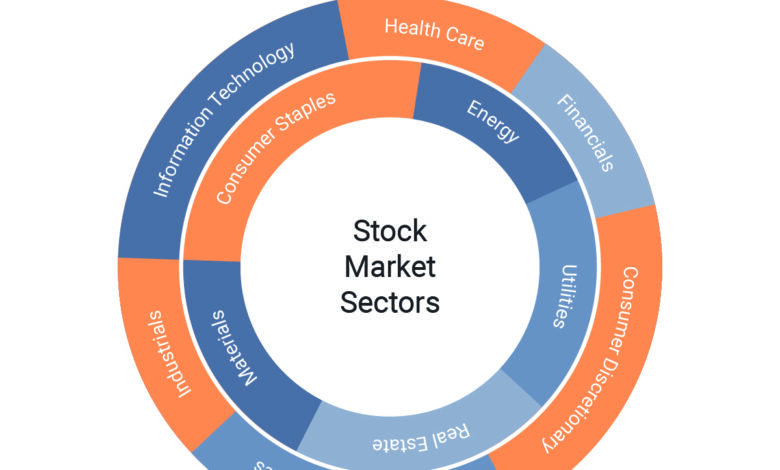Understanding the unique stock market sectors in India and where to successfully Invest, in 2022

Understanding the different stock market sectors in India and where to Invest
A stock market sector is a collection of equities that share several characteristics, usually because they are in the same industry. The most widely used classification system, the Global Industry Classification Standard, has 11 different stock market sectors (GICS).
We divide equities into sectors to make comparing companies with comparable business models easier. You can pick stocks from industries that interest you when it comes to investing. Sectors also make comparing which stocks make the most money easier. This aids you in making selections about your subsequent investments.
In a stock market, what are sectors?
The market is enormous. The National Stock Exchange of India, for example, has over 1900 companies listed (NSE). The NSE has almost 1900 firms in 11 industries.
The businesses are from various industries. Sectors are a means of categorizing companies in the stock market according to their sector of operation.
Continue reading to learn more about the different stock market sectors, with a focus on the Indian stock market.
Sorting the stocks
There is so much information available, yet so little time. Before allocating money to a particular stock, investors confront a complex problem.
When you know which books are on which shelves in a library, it’s much easier to walk over and select a title that best fits your area of interest. Similarly, grouping stocks into categories makes them more accessible to investors. As a result, classification saves a significant amount of time.
Similarly, sectors educate investors about industries where they should not put their money. During pandemics, for example, when air travel is limited, investors may prefer to avoid the tourism and aviation sectors.
In the Stock market, how many sectors are there?

Because of the rapid growth of the stock market, it has been divided into numerous sectors. However, how many sectors are there in the stock market?
There are 11 primary sectors in the stock market. The broad categories make it easier for portfolio managers to do their jobs. Traders can choose and choose based on their requirements and then tailor their portfolio by picking multiple sectors.
Different publicly traded corporations exist in each stock market sector. Each company in the industry has its own set of dynamics, which impact profitability.
Different ETFs (Exchange Traded Funds) can help you reach your asset allocation goals.
You can utilize a variety of parameters to assist you in performing a proper stock analysis and making the best investing decisions.
If you like to take fewer risks in the stock market, start investing in Blue Chip Companies, which provide lower risk and higher rewards.
The following are some of the most critical sectors in the Indian stock market:
- Commodities and Agriculture
- Aviation
- Automobiles
- Financial Institutions and Banks
- Electronics and Electricals
- FMCG
- Petroleum & Gas
- Information Technology
- Infrastructure
- Pharmaceuticals
- Property Management (Real Estate)
- Telecommunications
- Textiles
- Tourism
What are some of the major stock market sectors in India?
Some businesses are well-known, while others are less so. Sectors are helpful because they direct investors’ attention to hidden jewels. Among the many sectors in the stock market, there are four that you should be aware of:
Automobile Industry
This industry encompasses more than simply automobile manufacturers. It also houses commercial vehicles, 2-wheeler, 3-wheeler, and tractor manufacturers. Because India is an agricultural country, tractors and commercial vehicle manufacturers have a large following among Indian investors.
Examples:
- Maruti Suzuki
- Ashok Leyland
- Bajaj Auto
- Escorts
Tesla is the only pure-play electric vehicle manufacturer in India. Any change, though, is never far away.
Banks and the Financial Services Industry
The banking sector is notable because it earns money from money. The top line of banks is calculated using the cash flows of every other company on the market.
This is because practically every other company seeks bank financing to manage its capital structure. This is why profits from financial corporations are distinguished from non-financial enterprises. As a result, a sectoral approach to investing allows for this differentiation to be accounted for.
Non-banking financial companies (NBFCs), asset management companies (AMCs), rating and research institutions, insurance companies, and public and private banks are part of this vast industry. NBFCs serve the unbanked.
AMCs manage Mutual Funds. Rating organizations specialize in credit ratings while also earning money from research materials. Insurance companies aggregate little sums from many people to cover the loss of a few people.
Examples:
- ICICI Bank
- Bajaj Finserv
- Nippon Life AMC
- CRISIL
This is a sector to keep an eye on, as it will receive one of the biggest names in the insurance and fintech industries.
FMCG Sector

Companies in the FMCG sector make products that consumers buy and use regularly. Such items are quickly consumed. FMCG items ensure a consistent revenue stream, resulting in consistent earnings and a strong return on investment.
Examples:
- Hindustan Unilever
- Britannia Industries
- Colgate Palmolive
- Procter & Gamble
The FMCG industry is resilient to economic downturns. As a result, even on terrible days for the economy, your neighborhood grocery stores will be busy selling FMCG products.
Pharmaceutical Industry
Biologicals, active pharmaceutical ingredients, excipients, vaccines, and treatments for common and rare diseases are just a few of the pharma industry’s many products. Investors are becoming more familiar with the business due to the COVID-19 outbreak. Because the products are concerned with the well-being of global people, the industry is highly regulated.
Examples:
- Biocon
- Sun Pharmaceuticals
- Pfizer
- AstraZeneca
Pharmaceutical businesses have a unique advantage: unrivalled pricing power. Regulators are in place to prevent irresponsible behaviour, of course.
Financials
Financials encompasses all aspects of investment, finance, and money management. Examples are insurance businesses, banks, real estate, funds, credit card issuers, and other financial institutions.
When interest rates rise, loans and mortgages are the two areas that produce the most earnings.
The financial sector of the stock market is a popular one, as it houses all of the established and mature firms and companies.
Discretionary Service
Customer discretionary is a sector that involves the economy living on rising consumer wants. Corporations in this area include media companies, fashion companies, etc.
Customers do not require luxury as a condition of survival.
Utilities
As the name implies, utilities are companies that supply services such as gas, electricity, and renewable energy.
The utility sector generates consistent revenue by charging its customers.
For example, an electricity firm may distribute electricity in a specific territory before charging customers. In exchange, the fees will provide recurrent revenue.
Technologies of Information
The technology sector of the stock market includes all technological industries, enterprises, software developers, and information technology companies.
Information technologies include computer components, microprocessors, and operating systems. The technology sector of the stock market includes companies like Microsoft.
Medical Assistance
Health care is a crucial stock market industry because it is an essential aspect of every economy. Medication, hospital administration, pharmaceutical enterprises, medical equipment manufacturers, and so on are all part of the stock market’s health care industry.
Johnson & Johnson is a giant in the healthcare industry. Several implant manufacturing companies are listed in the health care sector of the stock market.
Industries
Excellent and thriving industries are the lifeblood of any economy. The industrial sector contains a large number of companies on the stock market.
This can include railways, aeroplanes, and even weapon manufacturing industries/companies.
The industries sector is one of the most diverse, with 14 distinct sectors. Logistics, equipment, and transportation companies make up the majority of the businesses.
Communication is important.
The telecommunications business helps people stay connected since communication is at the heart of every civilization. The communication industry can be divided into two categories.
The first section includes wireless services, cables, and even outdated wired connections. Telephone connections facilitate communication.
This sector’s importance has grown in recent years, thanks to the addition of the media and entertainment industries. The communication industry is divided into two parts.
The communication sector includes entertainment portals such as Netflix and Prime Videos.
Energy
Oil and gas are supplied to the general public by several companies. These businesses are included in the energy sector of the stock market.
Gas and oil firms and producers of other renewable resources like ethanol and coal are all part of the sector.
The category also includes companies that produce equipment for these energy sources. The price of natural gas, crude oil, and other commodities is often linked to the money made by such businesses.
Property Management
Real estate is one of the various stock market industries. The real estate industry is divided into two categories. Different stocks are available to help construct new homes and properties.
Furthermore, these are rented out, and cash is made. The principal source of income in the real estate industry is rent from these residential, professional, or other premises.
Materials
Many companies, including mining and chemical manufacturing companies, are categorized as producing items for manufacturing and various other applications under the materials system.
The enterprises in this category are at the very beginning of the regular cycle. This implies that it has the potential to disrupt the entire business cycle.
Best Indian Stock Market sectors to invest in

The stock market’s diverse segments allow investors to pick and choose before investing. Selecting the most delicate sectors to invest in the stock market can be challenging.
Here is a guide to assist you in researching and investing in the best industries so that your return is appropriate. We’ll also look at which stock market sectors are performing well.
IT Sector– The information technology sector is growing at a rapid pace.
For some users, these may appear to be one of the most costly stocks in India as more individuals have access to the business, but the ongoing expansion makes it a perfect place to put their money.
Health Care– There have been several developments in the health care business as the average life expectancy has increased. It’s always possible that the healthcare system will progress and expand. To ensure earnings, it is advisable to invest in the healthcare industry.
Consumer Staples– The food and beverage industry, an essential component of consumer staples, will never go out of business. This sector’s investments will never go to waste.
Consumer staples are products that customers are unwilling to cut from their current budget.
The best thing about the consumer staples sector is that you, as an investor, will not suffer too much if the economy falls apart.
Conclusion
The stock market has exploded in popularity, spawning many new industries. Stock market sectors are important because they simplify portfolio management for investors and portfolio managers.
The sectors assist them in placing the appropriate funds in the proper portfolio. It is also frequently recommended that investors diversify their investments to increase their chances of success.
The Indian market is divided into eleven sectors, including all industries and businesses. Financials, healthcare, real estate, energy, consumer staples, and communications are among the sectors.
The various sectors encompass a wide range of industries. Although all industries are growing at nearly the same rate, some have higher returns.
Healthcare, consumer staples, and information technology are the three most popular investment industries, as seen by the expanding trend. The returns are consistent, and there is a lower failure rate.
If properly understood and invested in a suitable area, the stock market can be a reliable source of income. Understanding the industries, conducting research, and investing in the proper ones are all critical.




